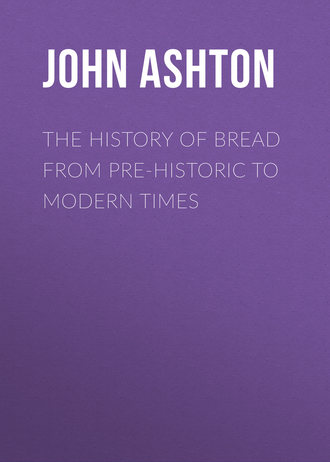 полная версия
полная версияThe History of Bread From Pre-historic to Modern Times
‘At the outset, it may be noticed that, as a precautionary measure against mishaps of any kind, many housewives were formerly in the habit of making the sign of the cross on their loaves of bread before placing them in the ovens, a practice which is still kept up in some parts of the country. Various explanations have been assigned for this custom, the common one being “that it prevents the bread turning out heavy.” In Shropshire one day remarked an elderly maidservant: “We always make a cross on the flour before baking, and on the malt before mashing up for brewing. It’s to keep it from being bewitched.” Some, again, maintain that the sign of the cross “keeps the bread from getting mouldy,” but whatever the true reason, it is persistently adhered to in the West of England. As, however, evil spirits and malicious fairies were generally supposed to be powerless when confronted with the sign of the cross, there is every reason to suppose that this is the origin of this superstition.
‘In days gone by, too, bread was used as a charm against witches, no doubt from its being stamped with the sign of the holy cross. Herrick, for instance, in his Hesperides, alludes to this usage in the following rhyme:
“Bring the holy crust of bread,Lay it underneath the head;’Tis a certain charm to keepHags away while children sleep.”Hags away while children sleep.”‘Bread, too, has long been employed as a physical charm for the cure of various complaints. Thus, an old book, entitled A Work for Householders, written in the early part of the 16th century, gives this charm as in use for the toothache. “The Charmer taketh a piece of white bread, and saith over that bread the Pater Noster, and maketh a cross upon the bread; then doth he lay that piece of bread upon the tooth that acheth or unto any sore, turning the cross unto the sore or disease, and so is the person healed.” Then there was the famous Good Friday bread, which was in request for its medicinal virtues, being considered a sovereign remedy for diarrhœa when grated in a small quantity of water. An anecdote is told of a cottager who lamented that her poor neighbour must certainly die, because she had already given her two doses of this bread, but, unfortunately, without any success. Indeed, in days gone by, so much importance was attached to bread thus baked, that there were in most parts few country houses in which it was not to be found. At the present day also one may occasionally find the custom kept up, especially in the Northern counties, where so many of the old beliefs survive.
‘But these are not the only ways in which bread has been the source of superstition, it having held a prominent place in numerous curious ceremonies. Thus sailors used it as offerings to propitiate the elements; and we are told how the seafaring community of Greece, in the 17th century, were accustomed to take to sea 30 loaves of bread, consecrated and named St. Nicholas’ loaves. In case of a storm these were thrown into the sea one by one, until they had succeeded in calming the waves.
‘Oblations of this kind were of frequent occurrence in past years. The Russian sailor, in order to appease the angry spirit that troubled the waters of the White Sea, would cast into the water a small cake or loaf made of flour and butter. Again, a Norwegian story states that a sailor wished, according to custom, to give on Christmas Day a cake to the spirit that presided over the waters; but, when he came to the shore, lo! the waters were frozen over. Unwilling to leave his little offering on the ice, the sailor tried to make a hole; but in spite of all his efforts it was not large enough for him to put his cake through. Suddenly, to his surprise, a tiny hand, as white as snow, was stretched through the hole, and seizing the offering withdrew with it.
‘To give a further illustration, we are told by a correspondent of Mélusine (Jan., 1885) that in the Isle de Sein “a little ship made of bread crusts is suspended over the table, and on Holy Thursday it is lowered down and burnt, while all uncover and the Veni Creator is sung. Another bread ship is then suspended over the table. This ceremony is known as the Ship Feast, and is designed to insure the safety of the family fishing boat.” Among further beliefs current among sailors in our own country is the notion that it is unlucky to turn a loaf upside down after helping oneself from it, the idea being that for every loaf so turned a ship will be wrecked. It is also said that if a loaf parts in the hand while being cut it bodes dissensions in the family – the separation of husband and wife.
‘Once more, bread is not without its many traditions and legendary lore. According to a popular tale told of the City of Stavoreen, Holland, there resided in it a certain rich virgin, who owned many ships. One day she entertained a wizard, but gave him no bread. In consequence of this serious omission he predicted her downfall, remarking that bread was the most useful and necessary thing. Soon after a shipmaster was bidden to procure the most valuable cargo in the world. He chose a load of wheat; but on arriving with his cargo, he was ordered to throw it overboard. It was in vain that he begged to be allowed to give it to the poor. Accordingly it was thrown into the sea; but the wheat sprouted, and a bank grew up, the harbour being ruined for ever. A Welsh legend tells how, many years ago, a man who dwelt in the parish of Myddvai saw three beautiful nymphs in the water, and courted them. They, however, called him “Eater of Hard-baked Bread,” and refused to have anything to do with him. One day, however, he saw floating on the lake a substance resembling unbaked bread, which he fished up and ate, and was thereby possessed of one of the lovely water-nymphs.
‘Thus, in one form or another, bread can boast of an extensive and widespread folk-lore, besides having in our own and other countries been made the subject of numerous proverbs, many of which are well-known from daily use as incorporating familiar truths. The common saying, for instance, which says:
‘Never turn a loaf in the presence of a Menteith,’ originated with Sir Walter Scott, in his Tales by a Grandfather, thus: Sir John Stewart de Menteith was the person who betrayed Sir William Wallace to King Edward. His signal was, when he turned a loaf set upon the table, the guests were to rush on the patriot and seize him. Then there is the phrase, “to cut large slices out of another man’s loaf,” referring to those who look after themselves at their neighbour’s expense. A popular Scotch proverb tells us that ‘Bread’s house skailed never”; in other words, a full or hospitable house never wants visitors; and, according to another old proverb, “Bread and milk is bairns’ meat, I wish them sorry that lo’e it.”’
THE END1
Narrative of an Expedition to the Zambesi and its Tributaries, by David Livingstone. Lond. 1865, p. 543.
2
Mulcture – fine.
3
Lose.
4
A measure containing 10 homers, or about 60 pints.
5
Vol. II., 89.
6
Vol. IV., 167, 168.
7
Ilios. By Dr. H. Schliemann. London, 1880, pp. 32, 33.
8
Prize.
9
Knot.
10
Hinges.
11
Nostrils.
12
Jongleur and joker.
13
Took toll thrice.
14
Some careful investigations have been made by M. Balland on the temperature which is reached in the interior of a loaf of bread during baking, and the results are published in the Comptes Rendus, Paris. Delicate thermometers were inserted in the dough before placing it in the oven, and on the removal of the loaf the temperature recorded was carefully noted. It seems that, contrary to the opinions expressed by some investigators – that the heat generated in the crumb of the bread never exceeds 212° Fahr. – that is to say, the temperature of boiling water – M. Balland finds that it invariably attains from 212° to 216° Fahr., while that of the outer crust, which cannot form at this temperature, is very much higher.
15
The English Bread Book for Domestic Use, &c., by Eliza Acton, London, 1857. 8vo.
16
A Glossary of Liturgical and Ecclesiastical Terms. By the Rev. F. G. Lee. London: 1877; p. 17.
17
He was a constant attendant in the crowds at Lord Mayor’s Day.
18
Tenures of Land and Customs of Manors, originally collected by Thomas Blount. London, 1874, 8vo.
19
A Collection of Old English Customs, etc. By H. Edwards. London, 1842.











